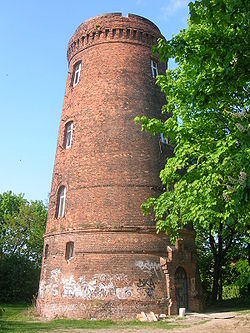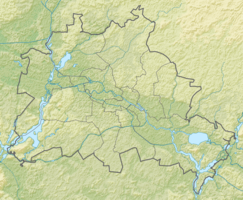Hohenschönhausen water tower
| Hohenschönhausen water tower | ||
|---|---|---|
 |
||
| Data | ||
| place | Berlin - Alt-Hohenschönhausen | |
| architect | Otto Intze | |
| Construction year | 1899 | |
| height | 23 m | |
| Coordinates | 52 ° 32 '51.5 " N , 13 ° 29' 19.1" E | |
|
|
||
The Hohenschönhausen water tower is a listed water tower in the Berlin district of Alt-Hohenschönhausen .
history
prehistory
A brewery was built on the initiative of the first Hohenschönhausen commercial enterprise . In 1892 the limited partnership Brauhaus Hohenschönhausen was founded, and in 1894 the first beer flowed . In the same year the terraces on the Obersee opened next door . In order to ensure the high water circulation and water consumption of the company, the brewery arranged for a small watercourse to be dammed up and the neighboring Obersee to be used as a process water reservoir. The village of Hohenschönhausen , which was founded in the 13th century and belonged to a manor for a long time, also needed water. The Brandenburg banker Henry Suermondt acquired the estate in 1890. Three years later, Suermondt founded the land acquisition and construction company in Berlin, which parceled out and built on the estate. First a country house colony was built on Lake Orankesee , and villas on Lake Obersee around the turn of the century . During this time, many commercial and industrial companies also settled. The water from the Obersee was actually only enough for the brewery. Thereafter, a water tower appeared to be necessary to ensure even pressure.
Water tower
In 1899 the land acquisition and construction company in Berlin was commissioned to build a water tower and the colony was also supplied with it. At first the water came from the lake and there must have been a small pumping station , but there are no more documents for this. The design for the tower and the water tank came from the Aachen engineer Otto Intze , who also held the patent for the tank design. He also worked closely with the Eschweiler container construction company FA Neuman. Water towers were built according to standard construction plans depending on the size of the tank. The company Erich Merten und Knauff built the tower, which went into operation a year later. The quality of the lake water was not very good, which is why a small groundwater works was built in the Waldowstrasse in 1901. This groundwater works pumps groundwater from a 51 meter deep well with two electrically operated piston pumps . The waterworks was taken over by the municipality, expanded to double the capacity. In 1917 and 1920, too, there were conversions and capacity expansions. In 1920, the chief engineer Walter took stock, put the length of the raw network at 30 kilometers and the number of people supplied to about 7,000 citizens. There were some deficiencies in the facility and opportunities for expansion. In 1921 the village of Hohenschönhausen was incorporated into Berlin. On April 25, 1921 there was a note at the municipal waterworks that the well was partially silted up and there was a lack of water . The Berlin works arranged for the Hohenschönhausen pipe network to have a connection to the Lichtenberg waterworks . The connection to the entire pipe network of the former municipality to the Berlin network was completed on July 1, 1922, and the plant, which was classified as uneconomical, was shut down, and the water tower was no longer usable.
The Berlin waterworks took over the facilities, but had no interest in the water tower. The waterworks and the district negotiated the future of the tower. When no agreement was reached by August 4, 1922, on October 30, 1922, the Müller city council asked the municipal utilities once again to first remove the storm damage to the tower and repair loose window panes . As in the previous years, the waterworks were asked at the end of 1924 to repair the damage because parts of the cornice had fallen off. The waterworks asked the city of Berlin whether the tower could be demolished . On February 14, 1925, City Councilor Müller replied that the district office had no objection, as they saw no possibility of use. On April 6, 1925, the tower was again offered to the district free of charge, with the indication that the building would fit well into the facilities and could be used for a bar . The district only agreed to a takeover if it took place free of charge and with all accessories. The takeover planned for August 1, 1925, was delayed again by 13 months because the waterworks wanted to continue using the tower as a warehouse for their building materials. The head gardener received the key to the tower on September 1, 1926. He wanted to use the tower as a warehouse for the horticultural department in the future. The Erich am Ende company was commissioned to dismantle the ailing, unused container, the lower part of the tower was retained. The tower was used at the end of World War II as an observation point for aircraft, after which the Soviet troops continued to use it. In 1973 and 1989 the Society for Sport and Technology ran an amateur radio station on the upper floor of the tower .
After the reunification , between 1993 and 2004 the newspapers reported that there were new ideas and interested parties for the tower. The first concept from 1993 included an architectural gallery with a restaurant. This failed because of the district's asking price. The district then decided to re-tender the tower either for sale or for lease under heritable building rights . In the summer of 1994, the district found a new buyer who wanted to use the tower for restaurants , a gallery and a lookout tower . Because of building law clarifications and because of the monument protection, the negotiations dragged on so long that the investors dropped out again in 1996, and a new tender followed. The main points of the tender were the purchase price of 580,000 German marks and the estimated renovation costs of 2 million German marks. There were three new plans for the tower, an Eros center, a business consultancy and an event restaurant. The district decided on the last suggestion. The entrepreneur only offered 150,000 German marks and withdrew from the business. In March 1998 the tower was sold for 150,000 German marks, this time a wine restaurant and bar should move in. The owner did not get in touch and did not respond to a letter. He had been given three years to start construction, so that the district office had no action until April 2001. Eventually the contract was terminated. A new tender followed in January 2003, and the tower was sold in May 2003. The owner Martin Krömer runs a bar and an apartment in the tower. The building permit was only granted in summer 2004. On the day of the open monument in September 2004 Krömer presented his plans. According to the monument authority, the outer shell may not be changed. In the upper part of the tower, Krömer has set up his own apartment and shielded it from curious visitors. The expansion of the supporting structures was very complex, because the false ceilings proved to be insufficiently stable, and was associated with high costs.
literature
- Jens U. Schmidt: Water towers in Berlin: capital of the water towers . Regia-Verl., Cottbus 2010, ISBN 978-3-86929-032-4 , pp. 71-75 .

